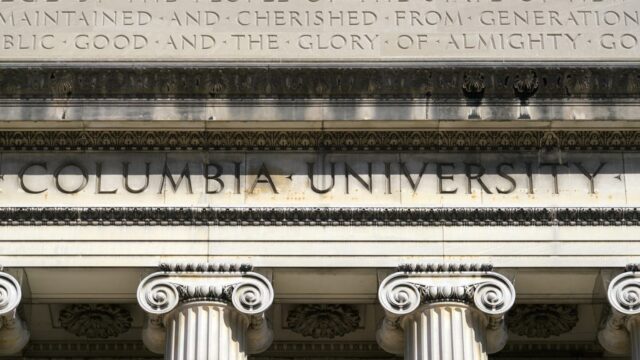A Reckoning for Higher Ed

A sense of fear is rippling through higher education—the fear that the Trump Administration will hold it accountable for violating federal law. As President Trump withholds millions in grants to Ivy League institutions, The New York Times’s Thomas Edsall innocently asks, “The American university system commands worldwide respect. What would prompt a call for its abolition?”
Like so many institutions, the American university system used to enjoy bipartisan trust and support. It once commanded broad-based respect, a respect that has been in freefall as the Left systematically dropped objective standards of excellence and the canon of Western civilization, replacing them with ever-evolving departments of grievance studies and activism. The majority of Republicans view American universities as a net negative. Independents are trending the same way, with just one-third saying they have “quite a lot” of trust in our universities.
On the basis of once high levels of trust, the universities secured enormous taxpayer benefits not given to any other sector. Now, they are shocked to find themselves in the process of losing their special carve-outs, which make up a substantial portion of their budgets. Losing these perks is a serious threat to their entire business model. In other words, as the kids say, FAFO.
As Chris Rufo and I wrote in City Journal, the Trump Administration is demanding three very reasonable, very popular things from the higher education sector: 1) follow basic civil rights laws and constitutional strictures against racial discrimination, 2) base admissions and hiring on merit rather than DEI victimhood points, and 3) help solve the student debt crisis that has made them immeasurably rich. Universities will have to bow to these demands or find a new way to operate that is not dependent on taxpayer money, much like what conservative schools such as Hillsdale College have been doing for decades.
Grants to universities total about $50 billion annually, making up huge portions of their budgets. Sure, some percentage of funds is important for research, but a large undetermined amount is directed toward woke nonsense and stoking racial grievance. The president of Johns Hopkins University recently wrote an alarmed letter highlighting the fact that his institution was “deeply tethered to the compact between our sector and the federal government.” He’s not the only one. Trump’s $400 million hit to Columbia’s budget represents only about half of what the feds usually send to the school every year; Yale beats them out with $900 million in funds that are now frozen.
What have universities done with lavish taxpayer funding and being entrusted with the immense power of being the pipeline to wealth, status, and influence? That the faculty lounges of elite schools are largely home to the most radical left-wing ideologues on the planet is old news. But in addition to hiring former domestic terrorists like Bill Ayers, universities employ a lot of paper-stamping bureaucrats.
Between 1976 and 2018, administrative positions increased by 164%. “Other employees”—distinct from professors, so essentially administrative—increased by 452%. The only category of employee that has grown more slowly at modern universities is full-time faculty. Schools have also increased the square footage of non-classroom facilities, building rock-climbing walls and lazy river pools. When the object is to entice every high school graduate into taking a federally offered six-figure loan, it helps to have extra incentives.
Federal money has also been used, of course, to pad the bottom line of enormous endowments. Columbia University, which is squealing about its $400 million haircut, has an endowment of nearly $15 billion. Harvard and Yale sport more than three times that amount. A surprising number of universities have endowments of more than $1 billion, which is more than the operating budgets of many U.S. municipalities.
These endowments were built not by the supremacy of an excellent product but on the back of federal money to fill in a large portion of their basic operating expenses, despite enormous and inflating tuition costs. In short, the typical university operating model today relies on the generosity of the American taxpayer, while at the same time teaching students that they and their country are irredeemably racist.
An Action Plan
One of the easiest ways to communicate that there’s a new sheriff in town is to pull funds based on schools’ publicly verifiable Title VI violations over the summer of 2024. This is the basis for the hit to Columbia that has sent shockwaves through the university world.
It’s important to note that Title VI does not punish mere speech. Instead, it requires the university to prevent actions that, based on race or sex, substantially interfere with a student’s right to take advantage of his education. If a student screams that he hates Jews in the quad, that’s protected speech. But if he follows Jewish students around, screaming it in their ears and preventing them egress across the quad, that’s harassment, and the school has a duty under civil rights law to prevent such an action.
The Left has no room to criticize the distinction between action and free speech, because they were the ones who largely supported the creation of this standard of race- or sex-based “harassment” in the courts.
But these are far from the only violations for which the Trump Administration has not only the ability but the duty under law to yank funding. Expect more schools to find their funding in jeopardy for:
- Continuing to discriminate against white and Asian students in admissions, which is a violation of the Equal Protection Clause as interpreted by the Supreme Court in Students for Fair Admissions.
- Discriminating against white and male applicants in hiring and publicly admitting to using racial criteria in hiring. Unlike affirmative action in admissions, this has never been legal despite its widespread practice both in universities and the private sector (a clear violation of Title VII). President Trump’s executive order on eliminating DEI authorizes a review of such practices in universities with endowments of more than $1 billion; that review will have a target-rich environment.
- Violating the Clery Act, which requires sending reports to the federal government of all incidents of lawbreaking on campus that are excluded from normal municipal police statistic reports, and levies substantial fines for failing to comply.
- Continuing to allow males into female sports on campus, damaging the rights of women athletes to equally enjoy the educational opportunities afforded by participation in fair competition. This is the basis for the administration withholding $175 million in grant funding from the University of Pennsylvania (a violation of Title IX).
Finally, while universities have had ample monies to grow their endowments and hire endless administrators, they’ve contributed suspiciously little toward solving the tuition hikes that have skyrocketed well above inflation, making college one of the largest expenses drowning the middle class. The Trump Administration demands that wealthy universities—institutions that took trillions in taxpayer subsidies—take responsibility for the student debt crisis, and for the growing chasm between their prices and the value of their degrees, a situation they helped create.
Instead of asking the majority of taxpayers without a four-year degree to foot the bill for the inevitable student bailouts, the institutions that contributed to the student debt problem should be stuck with it. There is already a tiny tax of less than 2% on large university endowments. That tax should be raised to 14%, or even to the normal hedge fund rate of over 30%, an idea that’s on the table as the House and Senate seek to pass a budget. Funds raised from acknowledging the reality that some universities are little more than hedge funds with woke madrassas attached should be put toward bailing out students who were deceived by university promises of future earnings, starting with the two in five students who do not graduate in six years and accumulate huge debts without a degree.
All of these moves by the Trump Administration and Republicans in Congress may seem radical to establishment elders and university presidents, but they are long overdue. Universities have built their entire business model around the generosity of the American people, but have failed to uphold their end of the bargain by containing their political activism and contempt. There has never been any reason for Republicans to send trillions to those who hate them and work toward making life meaningfully worse for their voters. The difference between Trump and past Republican presidents is that he sees this reality and is acting accordingly.
americanmind.org/salvo/a-reckoning-for-higher-ed/
